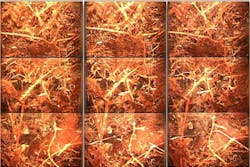Cameras get to the root of global warming
Researchers at the Oak Ridge National Laboratory (Oak Ridge, TN) are to use a system of minirhizotrons to examine the effects on elevated temperatures and levels of carbon dioxide on the roots of plants in wetlands.
A single minirhizotron consists of a digital camera attached to a movable sled within a sealed clear tube that is linked via a cable to a computer, which controls sled movement, collects, and transfers images of the roots to a server.
According to Colleen Iversen, an ORNL ecosystem ecologist, one of the benefits of the minirhizotron is its ability to track the birth and death of individual roots.
Ultimately, the minirhizotrons will be placed in a black spruce bog in Minnesota, the site for a multiyear experiment called SPRUCE (Spruce and Peatland Responses Under Climatic and Environmental Change). There, large, modified open-top chambers will allow researchers to manipulate air and soil temperatures and levels of carbon dioxide and evaluate the response of the ecosystem.
One of the reasons scientists are interested in high-carbon environments like the Minnesota bog is because they cover only 3% of global land surface but store nearly one-third of terrestrial carbon.
If the planet continues to warm, researchers hypothesize that bogs will dry out and the following microbial decomposition of organic matter could lead to a massive release of carbon dioxide into the atmosphere, resulting in more warming.
-- By Dave Wilson, Senior Editor, Vision Systems Design
